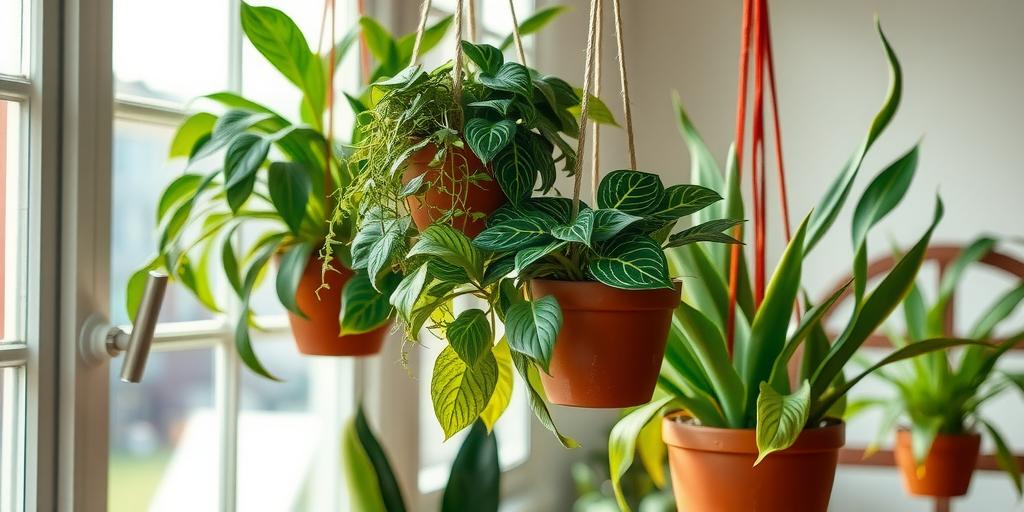
How to Decorate with Low Light Hanging Plants in Humid Rooms
Discover the best low light hanging plants for humid rooms and learn how to style them effortlessly! Perfect for bathrooms, kitchens, and dark spaces—bring life to any corner.
Introduction
Did you know that certain plants thrive in low light and high humidity? If you’ve struggled to keep plants alive in dim, damp spaces, you’re not alone! Hanging plants are a fantastic way to add greenery without sacrificing floor space—especially in rooms like bathrooms or basements. In this guide, we’ll explore the best low light hanging plants for humid environments, creative decorating tips, and easy care routines to keep them lush. Let’s turn those shadowy corners into thriving green oases!
Best Low Light Hanging Plants for Humid Rooms
Pothos (Epipremnum aureum)
If you’re new to indoor gardening, pothos is your best friend. This hardy plant thrives in low light and loves humidity, making it perfect for steamy bathrooms or kitchens. Its trailing vines grow quickly, so you’ll have lush greenery in no time. Plus, it’s forgiving—if you forget to water it occasionally, it won’t hold a grudge.
Spider Plant (Chlorophytum comosum)
Spider plants are practically indestructible. They adapt well to low light and actually enjoy the extra moisture in humid rooms. Bonus: they’re great air purifiers. If you notice tiny “spiderettes” (baby plants) dangling from the mother plant, you can snip them off and propagate them in water—instant free plants!
Philodendron Heartleaf
With its heart-shaped leaves and trailing vines, this plant adds a romantic touch to any space. It thrives in indirect light and appreciates humidity, so it’s a great choice for bathrooms. Just keep it out of direct sunlight, which can scorch its delicate leaves.
Staghorn Fern (Platycerium)
For something a little more exotic, try a staghorn fern. These unique plants love moisture and can be mounted on wood or hung in baskets. Their antler-like fronds make a striking statement, especially in a humid room where they’ll stay happy and hydrated.
Peperomia
If you’re short on space, peperomia is a fantastic compact option. Its thick, waxy leaves retain moisture well, making it ideal for humid environments. There are tons of varieties to choose from, so you can mix and match for a diverse hanging display.
How to Style Hanging Plants in Humid Spaces
Macramé Hangers
Macramé hangers add a boho-chic vibe while keeping your plants elevated and stylish. They’re perfect for pothos or philodendrons, allowing their vines to cascade beautifully. Plus, the natural fibers blend seamlessly with greenery, creating a cozy, organic feel.
Wall-Mounted Shelves
Why limit yourself to ceiling hooks? Wall-mounted shelves let you create a layered, cascading effect with your plants. Try pairing trailing plants like spider plants with upright varieties for a dynamic look. Just make sure the shelves are sturdy enough to hold the weight when the soil is damp.
Glass Terrariums
For a touch of elegance, glass terrariums are ideal—especially in steamy bathrooms. They trap humidity, creating a mini greenhouse effect that ferns and mosses adore. Open terrariums work well for plants that need airflow, while closed ones are perfect for moisture lovers.
Mix & Match Heights
Don’t hang all your plants at the same level. Combine ceiling hooks, wall brackets, and tabletop stands to create depth and visual interest. A tall staghorn fern paired with a trailing pothos at mid-height and a small peperomia near the floor makes for a lush, layered display.
Use Water-Resistant Materials
Humidity can wreak havoc on certain materials. Opt for coated metal, ceramic, or plastic planters to avoid rust and deterioration. If you love the look of natural materials like wood, seal them with a waterproof finish to prolong their life.
Care Tips for Low Light Hanging Plants
Watering
Even in humid rooms, overwatering is a common killer. Let the top inch of soil dry out before watering again. Stick your finger in the soil—if it feels damp, hold off. Most low-light plants prefer slightly dry conditions over soggy roots.
Misting
While humid air helps, some tropical plants (like ferns) appreciate an occasional misting. Use a spray bottle to lightly spritz their leaves, especially if your room’s humidity fluctuates. Just avoid misting plants with fuzzy leaves (like peperomias), as they can trap moisture and develop mold.
Pruning
Yellow or dead leaves? Snip them off! Regular pruning encourages new growth and keeps your plants looking fresh. Use clean scissors to avoid spreading disease, and don’t be afraid to trim back overgrown vines to maintain a tidy shape.
Fertilizing
During the growing season (spring and summer), feed your plants with a diluted liquid fertilizer once a month. Skip fertilizing in winter when growth slows. Over-fertilizing can lead to salt buildup in the soil, which harms roots—so less is more.
Pest Control
Humid environments can attract pests like spider mites or fungus gnats. Wipe leaves with a damp cloth to remove dust and deter bugs. If you spot pests, a mix of water and mild soap can help. For stubborn infestations, neem oil is a natural and effective solution.
Common Mistakes to Avoid
Overwatering in Humid Conditions
It’s easy to assume that humid rooms mean your plants need more water—but that’s not always true. Excess moisture can lead to root rot. Always check the soil before reaching for the watering can.
Placing Plants in Complete Darkness
“Low light” doesn’t mean “no light.” Even shade-loving plants need some indirect sunlight to thrive. If your space is too dark, consider supplementing with a grow light to keep them healthy.
Using Non-Draining Pots
Drainage holes are non-negotiable. Without them, water pools at the bottom, drowning the roots. If you fall in love with a pot that lacks holes, use it as a decorative cover for a plastic nursery pot that does drain.
Ignoring Dust on Leaves
Dust blocks light absorption, which is already limited in low-light conditions. Wipe leaves gently with a damp cloth every few weeks to keep them clean and efficient at photosynthesis.
Forgetting to Rotate Plants
Plants grow toward light, so if you don’t rotate them, they’ll become lopsided. Give them a quarter turn every time you water to ensure even growth and a balanced appearance.
By choosing the right plants, styling them creatively, and avoiding common pitfalls, you can turn any humid, low-light space into a thriving green oasis. Happy planting!
Conclusion
Decorating with low light hanging plants in humid rooms is easier than you think! With the right plant choices—like pothos, spider plants, and ferns—you can transform any dim, damp space into a lush retreat. Remember to style creatively, care consistently, and avoid common pitfalls. Ready to start? Pick your favorite plant and let nature brighten up those shadowy corners!
